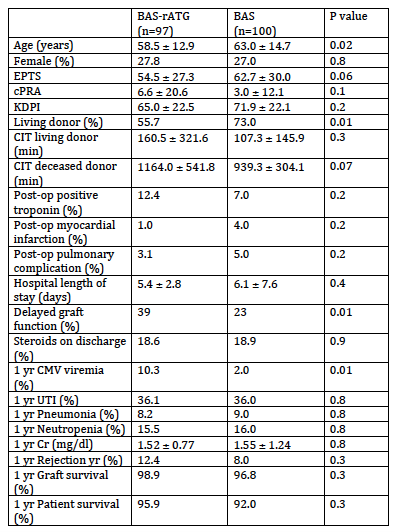The Challenge of Selecting an Induction Agent: A Dual Regimen for Medically High-Risk Kidney Recipients
Weill Cornell Medical Center, New York, NY
Meeting: 2020 American Transplant Congress
Abstract number: C-010
Keywords: Induction therapy, Kidney transplantation, Post-operative complications, Simulect
Session Information
Session Name: Poster Session C: Kidney Immunosuppression: Induction Therapy
Session Type: Poster Session
Date: Saturday, May 30, 2020
Session Time: 3:15pm-4:00pm
 Presentation Time: 3:30pm-4:00pm
Presentation Time: 3:30pm-4:00pm
Location: Virtual
*Purpose: Complications of the commonly used lymphocyte-depleting induction agent, rabbit anti-thymocyte globulin (rATG),include cardiorespiratory dysfunction with hypotension, tachycardia, myocardial infarction, and pulmonary edema. The choice of an induction regimen can be challenging for patients with significant cardiac or pulmonary disease. In an effort to identify novel induction protocols that increase efficacy and minimize possible toxicity, we analyzed the outcomes in a cohort of medically high-risk patients, using an alternative induction protocol that combines intraoperative basiliximab (BAS) with postoperative rATG.
*Methods: A single-center retrospective chart review of patients undergoing renal transplantation between 2009-2019. Exclusion criteria included having previously received a transplant, multiorgan transplants, or pre-operative desensitization. “BAS-rATG” group received intraoperative BAS induction followed by postoperative rATG (1.5mg/kg for 4-5 doses), while “BAS” group received 20 mg IV day 0 and day 4. Graft function, complications, rejection, and survival rates were compared.
*Results: The rates of postoperative cardiac and pulmonary complications were similar between BAS-rATG (n=97) and BAS groups (n=100) (Figure 1). Delayed graft function was more frequent in the BAS-rATG cohort (39% vs. 23%, p=0.01). At one year, recipients of the dual induction regimen did not demonstrate increased infectious complications or neutropenia, although CMV reactivation was higher. One-year graft function, patient survival, and rejection were similar between groups.
*Conclusions: A dual basiliximab-rATG induction regimen has similar efficacy and safety in patients with a significant cardiac or pulmonary history compared to use of basiliximab alone.
To cite this abstract in AMA style:
Craig-Schapiro R, Magaoay B, Grover R, Sultan S, Aull M, Kapur S. The Challenge of Selecting an Induction Agent: A Dual Regimen for Medically High-Risk Kidney Recipients [abstract]. Am J Transplant. 2020; 20 (suppl 3). https://atcmeetingabstracts.com/abstract/the-challenge-of-selecting-an-induction-agent-a-dual-regimen-for-medically-high-risk-kidney-recipients/. Accessed December 21, 2025.« Back to 2020 American Transplant Congress

